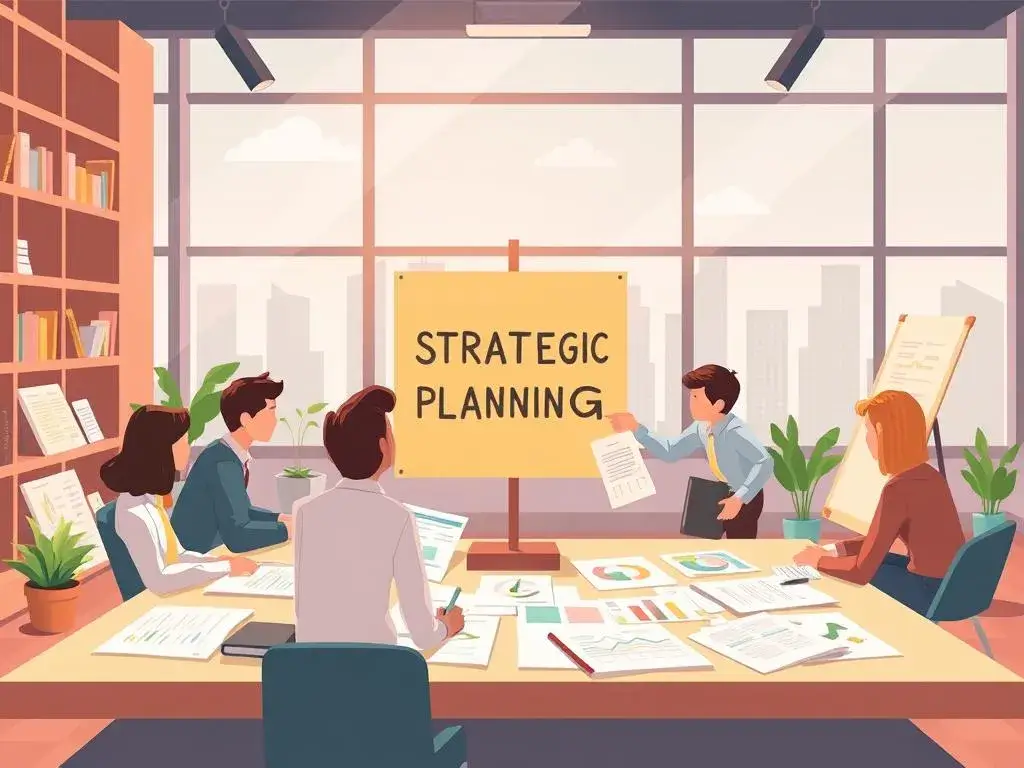Understand strategic planning: its concept, key characteristics, vital importance, and common constraints. Learn how to plan effectively!
Strategic Planning: Concept, Characteristics, Importance, and Process
Strategic planning is the process of developing and implementing strategies to achieve an organization’s long-term goals. It’s a fundamental self-assessment that establishes an enterprise’s direction and coherence.
This systematic, formally documented process focuses on the few critical, high-level decisions necessary for the organization to thrive over the next few years. It begins by asking fundamental questions:
- What is the organization currently doing?
- Should the current product line or method of operation be changed?
- How do external factors (social, political, technological, etc.) impact operations?
- Is the organization prepared to handle these changes?
Ultimately, strategic planning helps an organization understand its current position and its desired future state, enabling it to leverage its internal strengths and address weaknesses to capitalize on external opportunities and mitigate threats.
Definitions of Strategic Planning
Strategic planning can be defined in several ways:
- Managerial Process: A managerial process of developing and maintaining a viable fit between an organization’s objectives, skills, resources, and its changing environment.
- Goal Determination: The process of determining a company’s long-term goals and then identifying the best approach for achieving them.
- Resource Allocation: An organization’s process of defining its strategy or direction and making decisions on allocating its capital and human resources to pursue this strategy.
- Continuous Process: A continuous and systematic process where decisions are made about intended future outcomes, the methods of accomplishment, and how success will be measured and evaluated.
Key Characteristics or Features of Strategic Planning
- Process of Questioning: It involves critical self-reflection, asking: “Where are we and where do we want to go?” and “What are we and what should we be?”
- Long-Term Focus (Time Horizon): It is concerned with long-term goals, anticipating future environmental opportunities and threats, and enabling the organization to adapt.
- Pervasive Process: It occurs in all organizations and at all levels, though top executives are most involved as they are best positioned to envision the future.
- Focus of Attention (Resource Allocation): It directs the organization’s strengths and resources toward critical, high-priority activities, shifting resources away from routine or non-priority sectors.
- Continuous Process: It is an ongoing cycle, allowing organizations to constantly adapt to a dynamic and ever-changing environment.
- Coordination: It integrates the organization’s internal activities with the external environment, financial with non-financial resources, and short-term plans with long-term goals.
Importance and Benefits of Strategic Planning
Strategic planning provides numerous advantages to an organization:
- Financial Benefits: Organizations engaged in strategic planning generally report better sales, lower costs, higher earnings per share (EPS), and greater overall profits.
- Guides Organizational Activities: It provides a clear roadmap, unifying organizational efforts and guiding all members toward the established long-term goals.
- Competitive advantage: By allowing managers to foresee the future, anticipate problems, and frame proactive strategies, it helps firms gain and maintain a critical competitive advantage, which is vital in a globalized market.
- Minimizes Risk: It facilitates the assessment of risks and the framing of strategies to reduce them, thereby lowering the chances of choosing incorrect objectives or making costly mistakes.
- Manages Long Gestation Gaps: It is particularly beneficial for companies with a long gestation period (time between investment and income), as it helps managers anticipate and absorb disruptions from technological or political changes.
- Promotes Motivation and Innovation: The involvement of top-level managers fosters commitment to the objectives and encourages the generation of new ideas and innovative approaches for strategy implementation.
- Optimum Utilisation of Resources: It ensures the most effective and efficient use of resources to maximize output and achieve organizational goals.
The Strategic Planning Process
Strategic planning is a structured process involving a sequence of steps:
- Missions and Objectives:
- Mission Statement: A concise statement defining the organization’s purpose, what it strives to achieve, and its long-term vision.
- Objectives: Measurable, time-bound goals that the organization seeks to achieve, covering long-range aims down to specific assignments (e.g., financial and strategic objectives).
- Environmental Scanning or Surveying the Environment:
- External (Macro) Factors: Gathering and interpreting information on demographic, socio-cultural, economic, political, legal, and industry-specific factors to identify Opportunities and Threats.
- Internal Factors: Assessing the company’s capabilities and resources to identify internal Strengths and Weaknesses, core competencies, and competitive advantages (e.g., Competitive Advantage Profile – CAP).
- Strategy Formulation:
- Matching the organization’s strengths to external opportunities while addressing weaknesses and threats (SWOT analysis).
- Selecting the corporate strategy (e.g., cost leadership, differentiation) that provides the design for achieving goals and ensures a strategic fit between the firm and its environment.
- Strategy Implementation:
- Putting the chosen strategy into action through programs, budgets, and procedures.
- This involves organizing resources, motivating staff, designing suitable structure, and ensuring clear communication to all implementing managers.
- Evaluation and Control:
- Monitoring the strategy’s progress and making necessary adjustments.
- This includes: defining measurable parameters and targets, measuring results, comparing results to standards, and taking corrective actions. If the gap is due to a flaw in the original strategy, the process loops back to formulation.
Tools of Strategic Planning
Managers use several tools to aid in the strategic planning process:
- SWOT Analysis (Strengths, Weaknesses, Opportunities, Threats): A fundamental tool for assessing the internal business factors (Strengths, Weaknesses) and external environmental factors (Opportunities, Threats) to ensure the marketing plan aligns with the company’s resources and capabilities.
- Scenario Planning (The “What If” Process): Involves anticipating various possible future events or changes (scenarios) and analyzing their potential impact on the company. This allows for planning to minimize damage and maximize opportunities should a scenario occur.
- PEST Analysis (Political, Economic, Social, Technological): A specialized tool focused on analyzing external macro-environmental factors that can affect present and future business, guiding the creation of strategies to leverage positive trends and mitigate risks.
- Risk Analysis: The process of identifying and planning for vulnerabilities to various outside factors to ensure the company is buffered from foreseeable events.
- STP (Situation-Target-Path): A simple, three-part overview of the strategic planning method:
- Situation: Evaluating and analyzing the current situation.
- Target: Defining future goals and objectives (the desired future state).
- Path: Defining the map or course of action to achieve those goals.
- Goals Grid Method: A simple technique to help managers think more clearly and logically about organizational and company goals during strategic planning.
Limitations of Strategic Planning
While essential, strategic planning has several practical limitations:
- Problems of Change: In a complex, rapidly changing environment, unpredictable changes in technology, consumer tastes, or political conditions can quickly render a long-range plan irrelevant or flawed.
- Failure of People: Planning often fails due to human factors, such as:
- Lack of commitment from managers.
- Failure to develop sound strategies or clear objectives.
- Overlooking planning premises or an excessive reliance on past experience.
- Lack of top management support or resistance to change.
- Lack of Accurate Information: Planning’s quality depends on the accuracy of future forecasts. The inability to completely and accurately predict future events, coupled with a lack of precise information, can pose significant operational problems.
- Inflexibilities: Managers must work within certain constraints:
- Internal Inflexibilities: Human psychology (resistance to change, preference for the present), established organizational policies and procedures (which can stifle initiative), and long-term capital investments (which commit future actions).
- External Inflexibilities: Factors like social, technological, legal, and economic conditions over which managers have no control, limiting their scope of action.
- Time and Cost: The strategic planning process can be time-consuming and costly. Excessive time and resources spent on achieving high precision in planning can become dysfunctional and risk managerial effectiveness.
- Rigidity: Planning can sometimes create an undue sense of rigidity, leading to a “straitjacket” mode of work that stifles employee initiative and hinders adjustment to a changing environment.







